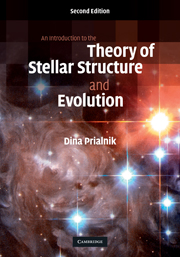Book contents
Summary
Having answered the two basic questions posed at the the end of Chapter 2, our present task is to combine the knowledge acquired so far into a general picture of the evolution of stars. We recall that the timescale of stellar evolution is set by the (slow) rate of consumption of the nuclear fuel. Now, the rate of nuclear burning increases with density and rises steeply with temperature, and the structure equations of a star show that both the temperature and the density decrease from the centre outward. We may therefore conclude that the evolution of a star will be led by the the central region (the core), with the outer parts lagging behind it. Changes in composition first occur in the core, and as the core is gradually depleted of each nuclear fuel, the evolution of the star progresses.
Thus insight may be gained into the evolutionary course of a star by considering the changes that occur at its centre. To obtain a simplified picture of stellar evolution, we shall characterize a star by its central conditions and follow the change of these conditions with time. We have seen that besides the composition, the temperature and density are the only properties required in order to determine any other physical quantity. If we denote the central temperature by Tc and the central density by ρc , the state of a star is defined at any given time t by a pair of values: Tc (t) and ρc (t). Consider now a diagram whose axes are temperature and density.
Information
- Type
- Chapter
- Information
- An Introduction to the Theory of Stellar Structure and Evolution , pp. 104 - 129Publisher: Cambridge University PressPrint publication year: 2009
